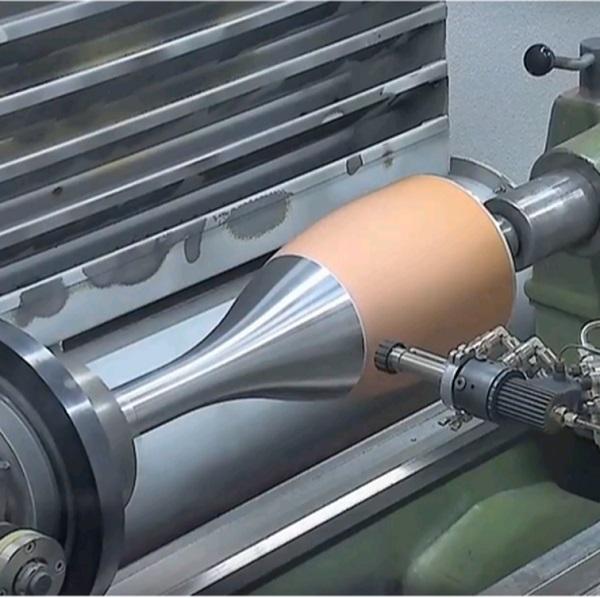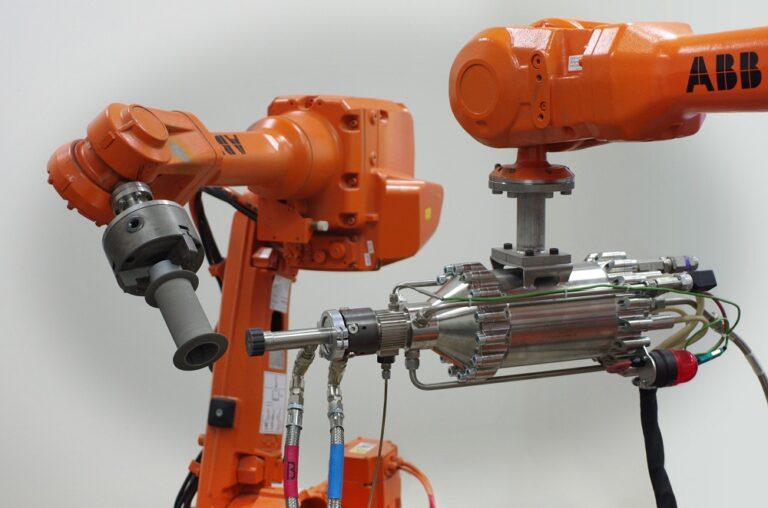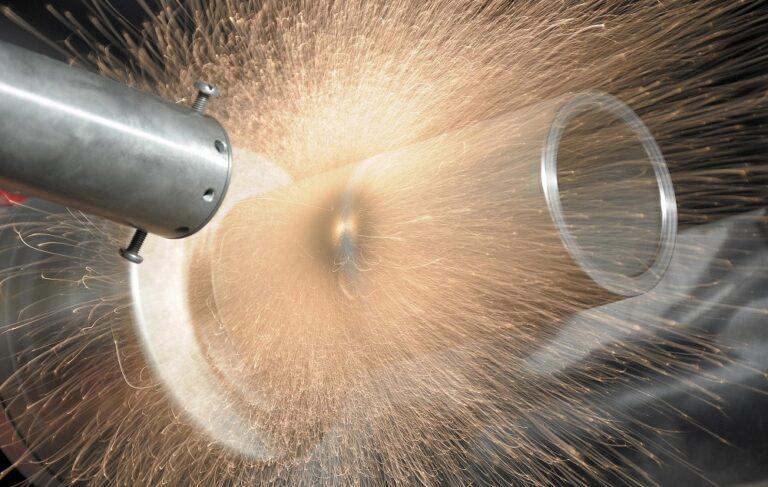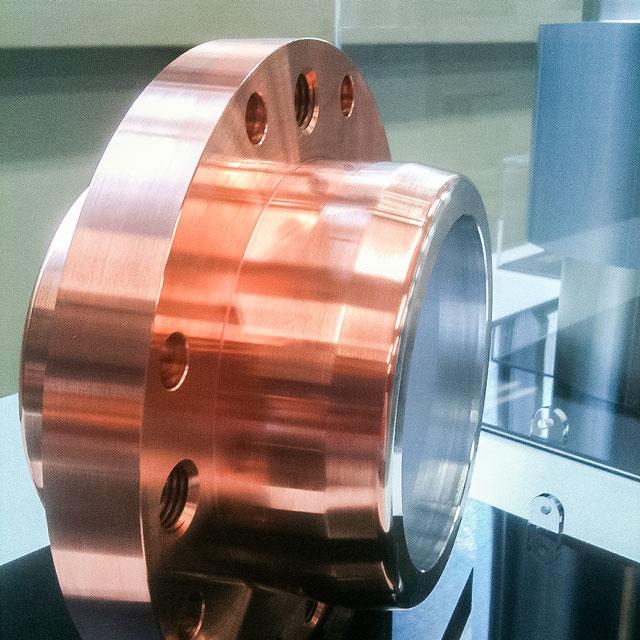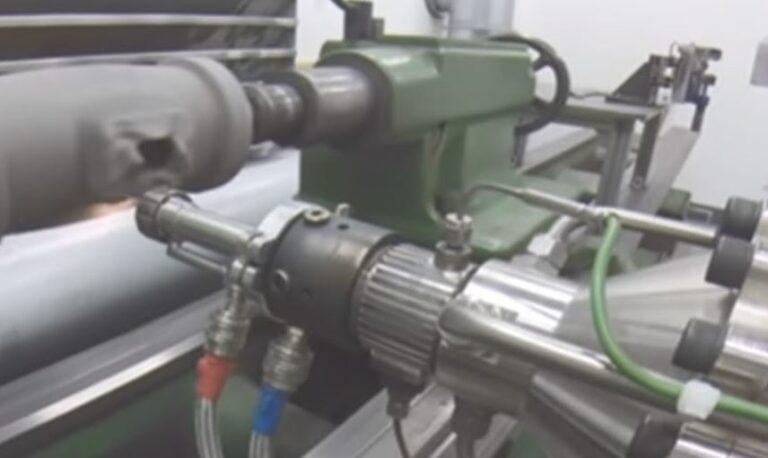Introduction to Cold Spray Equipment: How it Works and Its Applications
Understanding the Basics of the Cold Spray Process
Cold Spray coats using gas to speed up powder particles. The particles hit the substrate and form a dense coat. The coat sticks well due to the high-velocity impact. Cold Spray Equipment is the system that facilitates the cold spray process.
The main components of Cold Spray Equipment include a gas delivery system, powder feeder, nozzle, and substrate holder. Compressed gas, such as nitrogen or helium, is supplied to the gas delivery system and directed toward the powder feeder. The powder feeder dispenses the powder particles into the gas stream, accelerating the particles toward the nozzle.
The nozzle shapes and directs the gas and powder stream, creating a high-velocity jet that impacts the substrate. The particles are deformed and flattened upon impact, forming a dense coating. The substrate holder holds the substrate in place, allowing for precise control of its position during the process.
The cold spray process can be used for various applications, such as repair, restoration, and surface modification. It has many advantages, including low-temperature operation, reduced oxidation and distortion, and the ability to coat various materials.
In summary, Cold Spray Equipment facilitates the cold spray process with gas and powder. It creates dense and adhesive coatings. Understanding process basics and equipment components are crucial for success.
The Main Components of Cold Spray Equipment
Cold Spray Equipment consists of several essential components that work together to produce high-quality coatings. The four main components are the Gas Delivery System, Powder Feeder, Nozzle, and Substrate Holder.
The Gas Delivery System supplies compressed gas to the Powder Feeder, which dispenses solid powder particles into the gas stream. The gas and powder mixture then moves towards the Nozzle, which shapes and directs the stream to create a high-velocity jet that impacts the Substrate.
The Substrate Holder is responsible for holding the substrate in place and ensuring precise control over its position during the process.
Each component plays a critical role in the Cold Spray process. The Gas Delivery System determines gas type and pressure. It affects coating quality. The Powder Feeder controls the flow rate and size distribution. It impacts coating properties. The Nozzle’s shape and size dictate the particle acceleration and deposition efficiency, which determines the final coating thickness and density. The Substrate Holder is crucial for achieving uniform coating thickness and preventing substrate movement during the process.
In summary, Cold Spray Equipment consists of four main components: Gas Delivery, Powder Feeder, Nozzle, and Substrate Holder. Each component plays a critical role in the Cold Spray process and impacts the coating quality and properties. Understanding the functions and interactions between these components is crucial for achieving optimal coating performance.
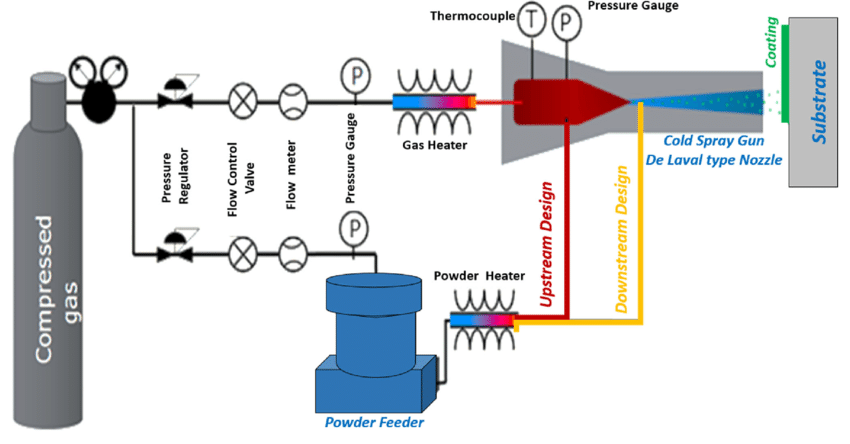
Gas Delivery System
The Gas Delivery System is a crucial component of Cold Spray Equipment. It delivers compressed gas to the Powder Feeder, which mixes it with solid powder particles and propels them toward the Nozzle. There are several types of gases used in Cold Spray, each with unique properties and functions.
The most commonly used gases are nitrogen and helium. Nitrogen is a cost-effective option and provides high particle velocity, while helium offers higher energy transfer and increased deposition efficiency. Other gases, such as argon and hydrogen, have also been used in Cold Spray.
The choice of gas depends on the specific application and desired coating properties. For example, nitrogen is suitable for producing hard and wear-resistant coatings, while helium is ideal for coating heat-sensitive materials.
Controlling the gas pressure, temperature, and flow rate can optimize the performance of the Gas Delivery System. Higher gas pressure and flow rate can increase particle velocity and deposition efficiency, while lower temperatures can reduce the risk of oxidation and distortion.
In summary, Gas Delivery System delivers compressed gas. Gas propels powder particles to the substrate. Adjusting pressure, temperature, and flow rate optimizes the process. The process significantly impacts coating properties. The gas type also affects coating properties.
Cold Spray Equipment Powder Feeder
The Powder Feeder is a critical component of Cold Spray Equipment. It delivers solid powder particles into the gas stream, which accelerates them toward the substrate. There are several types of Powder Feeders used in Cold Spray, each with unique advantages and disadvantages.
The most commonly used Powder Feeder is the auger-type feeder, which uses a rotating auger to dispense the powder particles. This type of feeder is reliable and easy to control, but it can be challenging to maintain a consistent flow rate and size distribution of the particles.
Another type of Powder Feeder is the ultrasonic feeder, which uses high-frequency vibrations to dispense the powder particles. This type of feeder can provide more precise control over the particle size distribution and flow rate, but it can be more challenging to maintain and more expensive.
The choice of Powder Feeder depends on several factors, including the type of powder used, the desired particle size distribution and flow rate, and the coating properties desired. The Powder Feeder’s performance can significantly impact the Cold Spray process’s efficiency and the final coating quality.
In summary, Powder Feeder is critical in Cold Spray Equipment. It dispenses solid powder particles. Types of feeders have advantages and disadvantages. Auger-type and ultrasonic feeders are two types. The choice of feeder depends on several factors. Optimizing the Powder Feeder’s performance is essential for achieving consistent particle size distribution, flow rate, and coating quality.
Types of Nozzles and Their Impact
The Nozzle is a critical component of Cold Spray Equipment responsible for shaping and directing the gas and powder mixture into a high-velocity jet. There are several types of Nozzles used in Cold Spray, each with unique designs and functions.
Cold spray equipment commonly uses the convergent-divergent (CD) nozzle, which accelerates the gas and powder mixture to supersonic speeds. This type of Nozzle can produce high-density coatings with excellent adhesion and mechanical properties.
Another type of Nozzle is the straight-bore Nozzle, which produces a lower particle acceleration rate and is more suitable for coating delicate substrates or producing thicker coatings.
The choice of a Nozzle depends on several factors, including the desired coating properties, substrate material, and particle size distribution. The Nozzle’s shape and size can significantly impact the particle acceleration rate and deposition efficiency, which determine the final coating thickness and density.
In summary, The Nozzle is critical. It shapes and directs gas and powder. It creates a high-velocity jet. CD and straight-bore Nozzles are different. They impact particle acceleration rate. They impact deposition efficiency. Choosing the right Nozzle is essential for achieving the desired coating properties and optimizing the Cold Spray process’s efficiency.
Substrate Holder
The Substrate Holder is a crucial component of Cold Spray Equipment responsible for holding the substrate in place during the coating process. It plays a vital role in ensuring consistent coating quality and adhesion by maintaining the substrate’s position and preventing it from moving or vibrating during the coating process.
The Substrate Holder’s design and construction are essential to achieve consistent coating thickness, density, and adhesion. The Holder should be capable of securely holding the substrate and applying the necessary force to prevent substrate movement during the coating process.
The Holder’s material should also be chosen carefully, taking into account the substrate material and coating properties desired. The Holder’s surface should be smooth, clean, and free of contaminants that could impact the coating’s quality and adhesion.
In summary, the Substrate Holder is a critical component of Cold Spray Equipment responsible for holding the substrate in place during the coating process. The Holder plays a crucial role in ensuring consistent coating quality and adhesion. To optimize the efficiency of the Cold Spray process and achieve the desired coating properties, you must carefully consider the design, construction, and material of the Holder.
Controlling Cold Spray Equipment
Effective control of Cold Spray Equipment is essential to achieve the desired coating properties consistently. The Cold Spray process parameters must be appropriately controlled to optimize the coating quality, thickness, and adhesion.
Process parameters such as gas flow rate, powder feed rate, nozzle geometry, and substrate temperature can significantly impact coating quality. A small variation in any of these parameters can result in significant differences in the coating’s properties.
Optimizing the gas flow rate can affect the particle velocity, density, and deposition efficiency, thereby influencing the coating’s quality and adhesion. Proper control of the powder feed rate and nozzle geometry can impact particle size, distribution, and velocity, leading to differences in the coating thickness and density.
The substrate temperature is also a critical process parameter that can significantly impact the coating’s adhesion and quality. The substrate must be maintained at a specific temperature range during the Cold Spray process to achieve optimal coating properties.
In summary, controlling the Cold Spray process parameters is crucial to achieving consistent coating quality and adhesion. The gas flow rate, powder feed rate, nozzle geometry, and substrate temperature are key process parameters that can impact coating properties. Proper optimization and control of these parameters can lead to the desired coating thickness, density, and adhesion.
Maintenance and Troubleshooting of Cold Spray Equipment
Cold Spray Equipment is a complex technology that requires regular maintenance to ensure long-term performance. The following are some best practices for maintaining and troubleshooting Cold Spray Equipment. First, it is important to keep the equipment clean and free of debris to prevent clogging and other issues. Regularly inspecting and replacing worn or damaged components such as nozzles, powder feeders, and gas filters is also critical.
In addition, monitoring and controlling process parameters such as gas flow rate, powder feed rate, and substrate temperature is essential for consistent coating quality. Proper calibration and regular testing of these parameters can help detect and address any issues before they lead to significant problems.
If problems do arise, it is important to diagnose and troubleshoot the issue as soon as possible. This may involve checking and adjusting process parameters, replacing damaged components, or conducting more thorough equipment inspections.
Regular training of personnel on proper equipment usage and maintenance can also help prevent issues and improve overall performance. By following these best practices, Cold Spray Equipment can be maintained and operated for optimal performance and longevity.
Advancements in Cold Spray Equipment: New Technologies and Applications
Cold spray technology has been rapidly advancing in recent years, leading to new developments in cold spray equipment and applications. One significant advancement has been the introduction of robotic cold spray systems, which allow for greater precision and control in the spraying process. Additionally, improvements have been made to powder feeders, resulting in better accuracy and consistency in particle size and distribution.
New materials have also been developed specifically for cold spray applications, including high-strength alloys and composite materials. These materials offer enhanced properties such as wear resistance, corrosion resistance, and improved thermal conductivity. Furthermore, advancements in nozzle design have led to the development of novel spraying techniques, such as cold spray 3D printing, which allows for the creation of complex and intricate geometries.
Another area of progress is the development of in-situ monitoring and control systems, which allow for real-time measurement of critical process parameters such as gas flow rate, temperature, and particle velocity. This allows for immediate adjustments to be made to ensure optimal coating quality and performance.
Overall, the advancements in cold spray equipment and technology have opened up new possibilities for industrial applications, such as aerospace, automotive, and biomedical industries, where superior coatings and material properties are necessary. With continued research and development, cold spray technology is poised to become an even more valuable tool for achieving high-performance coatings and advanced materials.
Choosing the Right Cold Spray Equipment
When choosing the right cold spray equipment for your industry and applications, there are several factors to consider. First, you need to determine the size and shape of the parts you will be coating, as this will impact the type and size of equipment you need. You also need to consider the type of material you will be spraying and the required coating thickness.
Another important factor to consider is the gas and powder delivery systems, as these will affect the quality of the coating and the efficiency of the process. Additionally, you should consider the type of nozzle and substrate holder, as well as any automation features that may be necessary for your specific application.
It is also important to choose a supplier that has experience and expertise in your industry and can provide support and training for your operators. Finally, you need to consider your budget and any regulatory requirements that may apply to your industry.
By carefully considering these factors, you can choose the right cold spray equipment that will provide the quality and performance you need for your specific industry and applications.
conclusion
As a result, cold spray equipment is a cutting-edge technology with many uses across numerous sectors. The effectiveness of a cold spray method is highly dependent on the caliber and efficiency of the employed machinery. The importance of regulating process parameters as well as many aspects of cold spray equipment, such as gas supply systems, powder feeders, nozzles, and substrate holders, have been covered in this article.
Consider criteria including material qualities, coating thickness, and production volume when selecting the best cold spray equipment for your industry and applications. The creation of new tools and applications, such as additive manufacturing and the restoration of damaged parts, has resulted from the developments in cold spray technology.
It’s essential to keep up with the most recent technological advances and advancements if you want to completely benefit from cold spray equipment’s advantages. You can produce coatings of the highest quality and increase production by taking the time to carefully select the right machinery and grasp how to control the process parameters. Therefore, don’t be reluctant to make an investment in this technology and utilize its possibilities for your unique demands.
How to integrate cold spray equipment into your existing manufacturing processes?
- Determine the Need for Cold Spray Equipment
Assess the types of manufacturing processes and the specific parts or components that require cold spray coatings.
- Choose the Appropriate Cold Spray System
Evaluate the different cold spray systems available on the market based on the type of powder feeder, nozzle, gas delivery system, and substrate holder.
- Ensure Adequate Space and Resources
Verify that your manufacturing plant has sufficient space, electrical power, compressed air, and gas supply to support the installation and operation of cold spray equipment.
- Train Your Staff
Provide your staff with proper training on the safe and effective use of cold spray equipment and techniques.
- Install and Calibrate the Equipment
Install the cold spray equipment in the appropriate location and calibrate it to ensure optimal performance.
- Develop Standard Operating Procedures (SOPs)
Create standard operating procedures for using the cold spray equipment, which includes safety protocols, powder handling and preparation, and cleaning and maintenance procedures.
- Conduct a Test Run
Perform a test run on a small scale to evaluate the performance and quality of the cold spray coatings.
- Integrate Cold Spray Equipment into Your Manufacturing Process
Integrate the cold spray equipment into your existing manufacturing processes and workflows, ensuring that it complements your current production system.
- Monitor Performance
Monitor the performance of the cold spray equipment and coatings regularly, and make any necessary adjustments or maintenance to ensure optimal results.
- Evaluate Results
Evaluate the performance of the cold spray equipment and coatings over time, and assess the impact on your production processes, product quality, and bottom line.
FAQs
Cold spray technology can benefit a variety of industries, including aerospace, automotive, biomedical, electronics, and more. It is particularly useful for repairing and coating metal parts.
While there is a learning curve associated with using cold spray equipment, it can be mastered with proper training and practice. Additionally, many manufacturers offer user-friendly systems and software to simplify the process.
Cold spray is a unique coating method that involves accelerating metal particles to high velocities using compressed gas. Unlike other coating methods such as thermal spray, cold spray does not require high temperatures, resulting in minimal heat damage to the substrate and reduced distortion of the part being coated.
Yes, many manufacturers offer customizable cold spray equipment tailored to specific applications and industries. This can include features such as specialized nozzles, powder feeders, and gas delivery systems.
Yes, cold spray equipment is considered a more environmentally friendly coating method compared to other methods such as thermal spray, which can produce harmful emissions. Additionally, cold spray does not require the use of toxic chemicals or solvents in the coating process.
The time it takes to coat a part using cold spray equipment can vary depending on the size and complexity of the part, as well as the specific equipment being used. However, the process is generally faster than other coating methods due to the high particle velocities achieved through compressed gas acceleration.

